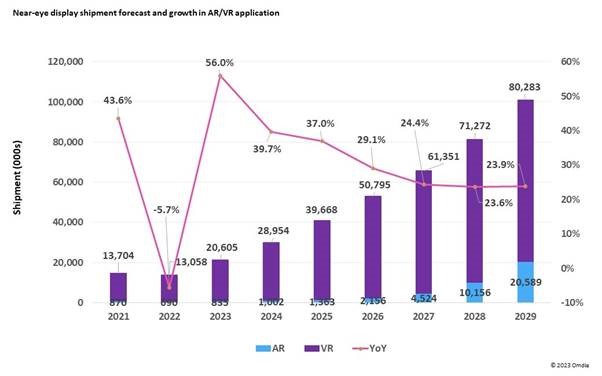Near-eye display shipments in wearable XR applications will grow by 56%
Near-eye display shipments for XR (Extended Reality) applications, including AR (Augmented Reality), VR (Virtual Reality), and MR (Mixed Reality) will grow 56% year-on-year (YoY) to 21.4 million units in 2023 according to the latest Near Eye Display for XR Application Report – 2023 from Omdia.
Conventionally, wearable XR devices are designed as the form factors of head-mounting and smart glasses. Near-eye display shipments declined by 5.7% in 2022 due to weak demand, inflation for budgets, and uncertainty following the geopolitical conflict.
Omdia Senior Research Analyst, Kimi Lin commented: “Better performance is expected in 2023 as near-eye display shipments will grow by 56% in 2023 thanks to the new VR models released or announced in the first half of 2023 such as Sony PSVR 2, Apple Vision Pro and Meta Quest 3. All these new XR devices are equipped with dual displays, which is expected to increase display shipments considerably.”
As for display revenues, Omdia estimates the revenue growth (up 59% YoY) is better than that of the shipments in 2023. This is primarily because brands adopt AMOLED or OLEDoS (OLED on Silicon) in these new products. The higher-priced displays are helpful to drive higher revenue growth.

Display shipments for VR applications account for more than 95% shares out of all XR-used display shipments in 2023, and Omdia estimates the dominance can last till 2026. Due to LTPS TFT LCD and AMOLED with mature manufacturing and affordability, both display technologies applied for VR application obtain higher adoptions and shares.
On the other hand, displays for AR applications are mostly silicon-based, such as LCoS (liquid crystal on silicon), LBS (laser beam scanning), DLP (digital light processing), OLEDoS and LEDoS (micro-LED on silicon). Although OLEDoS is prevalent now, its brightness is far from the requirement of outdoor use, which has strong ambient light interference. LEDoS has much higher brightness. If LEDoS display manufacturing can be actualised in three to five years later, there is potential to adapt into many AR applications. Omdia estimates the timing for LEDoS surging could be in 2027.





